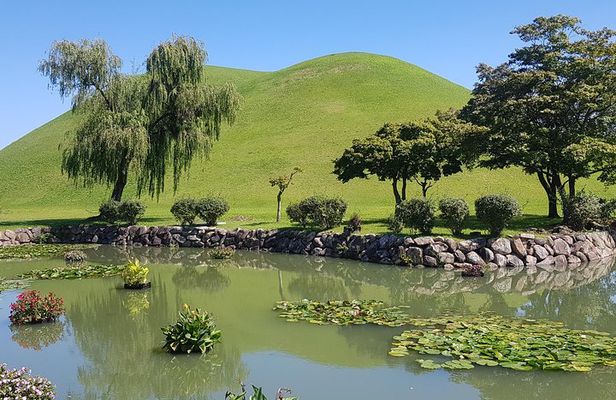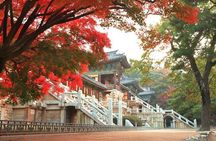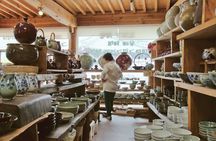
No expiration date
Easy refund
Free exchange
Easy booking
1-DAY Gyeongju UNESCO and Culture tour.
$400
This is an experience gift voucher. The recipient will book the experience after
they redeem the gift voucher.
Overview
Gyeongju stands as the ancient capital of the Silla dynasty, which ruled Korea for nearly 1,000 years. This city showcases significant remnants of its cultural achievements and lavish lifestyle.
- 🏛️ Visit Seokguram and Bulguksa Temple, both UNESCO World Heritage Sites.
- 🍽️ Lunch options include traditional local food to enhance your cultural experience.
- 🎨 Explore the Folk Craft Village for insights into local craftsmanship.
- 🏞️ Enjoy the scenic beauty of Bomun Lake and visit the Daereungwon Tomb Complex.
- 🕰️ Discover Cheomseongdae, an ancient astronomical observatory, and Gyeongju Gyochon Traditional Village.
- 🏛️ Tour the National Museum for a deeper understanding of Gyeongju's history.
—
The experience offers several options. This price includes:
Transport with driver
Mini Van, Mini Bus, Coach Bus: Share transport other small groups with a Korean driver (Simple English)
Pickup included
Mini Van, Mini Bus, Coach Bus: Share transport other small groups with a Korean driver (Simple English)
Pickup included
Tour guide
Language: English
Human tour guide
The experience offers several options, check yours above
- Gas + toll + parking fees
- Entrance decides to go to places and pay yourself on the spot
- Guide + driver or driving guide
- Free pickup and drop-off
- Busan, Gyeongju free transport service after the tour
- Private transportation
- Daereungwon Tomb KRW 3,000/per Wolji Pond KRW 3,000/per
- Meals
- Seokguram is an artificial grotto constructed of granite, comprising an antechamber, a corridor, and a main rotunda. It enshrines a monumental statue of the Sakyamuni Buddha looking out to sea with his left hand in dhyana mudra, the mudra of concentration, and his right hand in bhumisparsa mudra, the earth-touching mudra position. Together with the portrayals of devas, bodhisattvas and disciples, sculpted in high and low relief on the surrounding walls, the statues are considered to be a masterpiece of East Asian Buddhist art. The domed ceiling of the rotunda and the entrance corridor employed an innovative construction technique that involved the use of more than 360 stone slabs. (pass by)
-
Bulguksa TempleBulguksa is a Buddhist temple complex that comprises a series of wooden buildings on raised stone terraces. The grounds of Bulguksa are divided into three areas – Birojeon (the Vairocana Buddha Hall), Daeungjeon (the Hall of Great Enlightenment) and Geungnakjeon (the Hall of Supreme Bliss). These areas and the stone terraces were designed to represent the land of Buddha. The stone terraces, bridges and the two pagodas – Seokgatap (Pagoda of Sakyamuni) and Dabotap (Pagoda of Bountiful Treasures) – facing the Daeungjeon attest to the fine masonry work of the Silla.
-
Gyeongju Folk Craft Village consists of 40 thatched and tile-roofed houses, lived in by local artisans of traditional arts and crafts skills. Various fields of crafts production including metal, pottery, timber, jewels, hanbok (Korean traditional clothes), and stone crafts can be found in the village.
-
Large ancient tombs of kings and nobles of the Silla Kingdom can be seen around Gyeongju at the Daereungwon Tomb Complex. There are twenty-three large tombs located here; 13 have been excavated but only 1 (Cheonmachong - tomb of King Michu) is open to the public. The tomb chamber contained a lacquered wooden coffin that had burial goods placed around it. A total of 11,500 artifacts were recovered from the tomb, demonstrating the king's lavish lifestyle. The tomb was excavated in 1973 and is believed to date probably from the fifth century.
-
Gyeongju Gyochon Traditional VillageAt Gyeongju Gyochon Village, visitors can see the House of the Gyeongju Choi Clan (Important Folklore Material No. 27) and try some Gyeongju Gyodong Beopju Liquor (Important Intangible Cultural Asset No. 86-3). The village centers around the Gyeongju Choi Clan, a family known to have maintained their wealth for over 12 generations, producing many important people. Visitors can learn about the lifestyle and spending habits that enabled the family to do this. The village is also home to the site of Yoseokgung, the house of Silla Princess Yoseok. Nearby attractions include Gyerim Forest, Naemulwangneung Royal Tomb, and Gyeongjuhyanggyo Local Confucian School
-
Cheomseongdae ObservatoryCheomseongdae Observatory, constructed during the reign of Queen Seondeok (r. 632-647), is one of the landmark of Gyeongju. The observatory was built in a cylinder shape at approximately 9 meters in height. The observatory consists of 365 stones, symbolizing the number of days in a year. The rocks are piled in 27 layers symbolizing the 27th ruler, Queen Seondeok, and the days in a lunar month by adding the of two rock layers on top. It stands 9.17m high and the base stone on each side measures 5.35m.The Vernal Equinox, Autumnal Equinox, Winter Solstice, Summer Solstice and the 24 solar terms (also known as the astronomical solar year) were determined by observating of stars. The pavilion stone is believed to have been used as a standard of deciding directions, north, south, east and west. The 362 stones used to build Cheomseongdae represented the 362 days in a lunar year.
-
Gyeongju National MuseumGyeongju National Museum is loved by visitors and residents alike as it houses numerous historical and cultural artifacts of the Silla dynasty (57 BC - AD 935). The museum recently went through renovation, separating into an art gallery, historical artifacts exhibition hall, Wolji Pond exhibition hall, and a planned exhibition space. In addition to improving facilities for visitors' convenience, Gyeongju National Museum is making efforts to contribute to the community and reestablish its identity as a museum by making efforts to provide lifelong learning opportunities and improve management. As a significant cultural center, Gyeongju National Museum not only strives to preserve, exhibit, and research the rich history and culture of Silla, but also to take a leap forward to become a cultural multi-complex center by promoting international exchange opportunities, social education programs, and a variety of special exhibitions.
-
Donggung Palace And Wolji PondAnamji pond ( Donggung Palace and Wolji Pond ) Gyeongju Donggung Palace and Wolji Pond was a secondary palace used by the crown prince of the Silla Kingdom. It also served as a banquet site for important national events and important visitors. The pond was created in 674, during the reign of King Munmu. The pond features three small islands, and a landscape of 12 small hills to the northeast. After the fall of Silla, the site was abandoned and forgotten. The pond was referred to as "Anapji" from the Goryeo and Joseon periods and onwards. In the 1980s, a pottery fragment with the letters “Wolji” (a pond that reflects the moon) carved onto it was found, revealing the true name of the pond. After the discovery, the site was renamed to the current Donggung Palace and Wolji Pond.
How it works?
01
—
You choose from 10,000+ experience gifts
02
—
We deliver the eVoucher or the Physical box to the recipient
03
—
Recipient books the experience and creates unforgettable memories!
1-DAY Gyeongju UNESCO and Culture tour.
$400
This is an experience gift voucher. The recipient will book the experience after
they redeem the gift voucher.
How it works?
01
—
You choose from 10,000+ experience gifts
02
—
We deliver the eVoucher or the Physical box to the recipient
03
—
Recipient books the experience and creates unforgettable memories!




